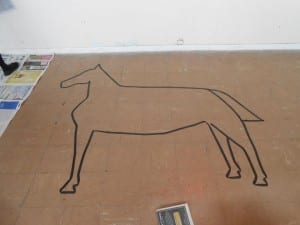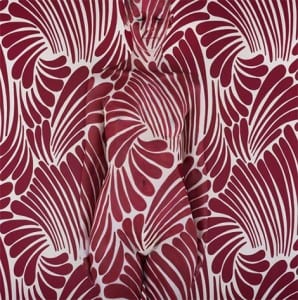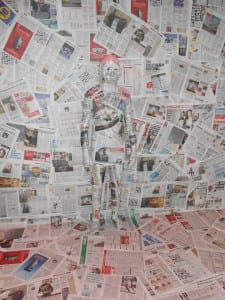‘I can take any empty space and call it a bare stage’ ((Brook, P. (1996) The Empty Space, New York: Touchstone. P7)) says Peter Brook in his book The Empty Space. And that is exactly what we faced when we turned up at the Grandstand- an empty space. We were to bring this space to life with our performance.
On the morning of performance day we had several things we needed to sort out and confirm with each other. First of all, we had to decide whether or not we were going to use music- we had previously discussed using the famous William Tell Overture, as it has a connection to horse racing due to Spike Jones covering it in 1948 as an underscore to a horse racing commentary. We all agreed to use it, as it would start just as we rip the newspaper off of ourselves and as we gradually begin to build the excitement of shouting out horse bets and odds. Another thing we had discussed previously was using quotes about gambling from in the Bible, especially as we had found that one we thought fit nicely in with our theme of loss: “People come into this world with nothing, and when they die they leave with nothing.” Ecclesiastes 5vs 10-17 ((The Holy Bible, New Century version, 2003: Thomas Nelson Inc)) This quote sums up the journey that the Grandstand has gone through; it went from being nothing, to being an active and focal point of Lincoln, and now has gone back to being nothing (this time in a metaphorical sense.) It also describes the journey that our piece will take; the empty Grandstand, which then comes to life through our performance and through sound and movement, and then gets all packed away and goes back to being empty.
We began to assemble our set, and by this I mean we wallpapered the walls with newspaper! We taped out the outline of the horse on the floor, along with the box for where the audience were to stand. We wanted the audience to be in the centre of the action, similar to how The Performance Group’s “[p]roductions such as Dionysus in 69 (1968-69) avoided end-on perspectives [and] put the audience closer to and often in the action” ((Allan, P. and Harvie, J. (2006) The Routledge Companion to Theatre and Performance. Oxon and New York: Routledge. P149)) We then covered the rest of the floor with the newspaper. We did come across a problem whilst we were setting up, as we were performing in the daytime and it was quite a sunny day, the room would not be dark enough to see the projection of Muybridge’s moving horse. To combat this we started to cover the windows with newspaper to try to black them out, this worked to an extent- it did not make it dark, but made it dim enough to be able to see the projection. The room no longer looked empty; in fact it looked incredibly busy with it being almost completely covered in newspaper!
Due to the TANK group performing in the same room as us, we needed to find a way to distinguish between their performance time/space and ours. Around the room were heaters fixed up on the wall, when they were turned on they glowed red and cast a red light around the space, we decided that we would turn these on when it was time for our performance that way there would be a change in atmosphere.
Soon it was performance time.
We had a fair sized audience, and the box we had drawn on the floor for them to stand in was actually a little too small. But this wasn’t such a problem, as we were able to walk around them. We created a really great atmosphere when we were shouting out the odds of different horses, the music worked really well underneath too; it felt exciting and slightly chaotic, which was what we were after. At the end of this section we threw large handfuls of the betting slips into the air above the audience and they showered down upon them, they seemed to really enjoy this and looked in awe as the slips scattered around them. The only thing that didn’t work so well in performance was when we all lined up in front of the projection and held up copies of the Racing Post to allow the projection to be projected onto the newspapers instead of the wall. In doing this we were too far to one side of the projection, so it obscured the view of the video slightly.
As we swept away the newspaper on the floor I could hear members of the audience asking each other what the black tape on the floor was, and then as the final pages of newspaper were pushed aside I could hear them gasp as they realised and acknowledged that it was a horse. When we brought out the plate of Tesco meat, a few members of the audience laughed as they made the connection to the scandal.
All in all I think the performance went brilliantly. I believe we effectively brought the Grandstand back to life, we made it stand out and become noticed and we helped to, as Mike Pearson states, “enhance public appreciation and understanding” ((Pearson, M. (2011) Why Performance? http://blackboard.lincoln.ac.uk/webapps/portal/frameset.jsp?tab_tab_group_id=_2_1&url=%2Fwebapps%2Fblackboard%2Fexecute%2Flauncher%3Ftype%3DCourse%26id%3D_67088_1%26url%3D)) of this site. Many of the audience may have arrived with very little knowledge or idea about the Grandstand, but I am confident that they left with a much better picture of how things would have been and felt in its many histories.


